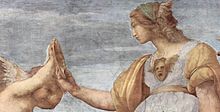Cardinal virtue
As a cardinal virtues (from the Latin cardo "hinge, pivotal point"; also primary virtue ) is known since the ancient times , a group of four basic virtues . Initially, these were not the same for all authors. A group of four is already in Greece in the 5th century BC. BC and was probably known earlier; the term "cardinal virtues" was first used in late antique patristics by the church father Ambrosius of Milan in the 4th century.
Antiquity
The group of four main virtues is first documented by the Greek poet Aeschylus , in his 467 BC. The piece Seven Against Thebes (verse 610). He seems to assume they are known; therefore it is assumed that it was used by the Greek nobility of the 6th century BC. Were common. Aeschylus characterizes the seer Amphiaraos as a virtuous man by calling him
- understanding (sóphron) ,
- just (díkaios) ,
- pious (eusebés) and
- called brave (agathós) .
The term agathós (“good”) is to be understood here, as in many inscriptions, in the sense of “brave” (andreios) .
Plato adopted the idea of a group of four in his dialogues Politeia and Nomoi . He kept his bravery (ανδρεία with him andreia ), the justice (δικαιοσύνη, dikaiosyne ) and Prudence (σωφροσύνη, sophrosyne ) in, but replaced the piety (εὐσέβεια, Eusebeia ) through wisdom (φρόνησις, PHRONESIS ) or wisdom (σοφία, sophía ). This displaced piety from the catalog of virtues. Even Plato's contemporary Xenophon , who, like Plato, was a pupil of Socrates , attributed a canon of only two virtues to Socrates, namely piety (which determines the relationships between people and gods) and justice (which is decisive for the relationships between people).
In his conception of an ideal social order (πολιτεία, politeía), Plato assigns a virtue to each of the three parts of the soul he has assumed and to each of the three classes, namely the highest part of the soul or class wisdom, the second class courage and the lowest class understanding or ability of moderation . Justice is assigned to all three; it ensures that the parts of the whole work together correctly.
Not only the members of the academy founded by Plato , but also the Stoics adopted the canon of the four virtues; The group of four also found its way into the rhetorical handbooks from stoic literature . Hence the educated of the Hellenistic and Roman worlds were familiar with it.
The same four main virtues were taught in Judaism; they appear twice in the Septuagint (the Greek translation of the Tanach ), namely in the Book of Wisdom (8.7) and in the 4th Book of the Maccabees (1.18). The Jewish philosopher Philo of Alexandria also dealt with it; he allegorically interpreted the four rivers of paradise as the four virtues.
Marcus Tullius Cicero , who relied on a work by the Stoic Panaitios that has not survived , represented the doctrine of the four main virtues. He introduced her to the Roman world. In his De officiis (On Duties) he mentions and discusses the four virtues:
- Justice (iustitia) ,
- Temperance (temperantia) ,
- Bravery and high sense (fortitudo, magnitudo animi or virtus) and
- Wisdom or prudence (sapientia or prudentia) .
middle Ages
Ancient doctrines of virtue are reflected in the interpretation of the Bible with the reception of ancient philosophy by Christian theologians such as Ambrosius , Hieronymus , Augustine , Bede and Hrabanus Maurus . In the 4th century, Ambrose of Milan wrote a doctrine of duties (De officiis ministrorum), in which he deals with Cicero's view. He first used the term "cardinal virtues" ( virtutes cardinales ); but the expression "main virtues" ( virtutes principales ) is more common with him . He adopted Philon's interpretation of the four rivers of Paradise as the four virtues.
A first systematic formation receives the doctrine of virtue within the moral teaching of Thomas Aquinas , who called the cardinal virtues as Angel, in which all other virtues are fixed: "A virtue is called cardinal or principal virtue, because the other virtues are attached to it like the door in the hinge . "( Virtus aliqua dicitur cardinalis, quasi principalis, quia super eam aliae virtutes firmantur, sicut ostium in cardine. )
enlightenment
Immanuel Kant only allows one primary virtue to apply in relation to the secondary virtues: "It is not possible to think anywhere in the world, indeed even apart from the same, that which could be considered good without restriction other than a good will alone." all other virtues can "also become extremely evil and harmful".
The German philosopher Johann Friedrich Herbart mentions cardinal virtues:
Modern
In the tradition of Thomas Aquinas, the philosopher Josef Pieper identifies the following Christian cardinal virtues:
- Cleverness ,
- Justice ,
- Bravery ,
- Moderation .
He gives prudence first. Out of it all other virtues are born. Wisdom is the measure of justice, bravery, and moderation. In the disoriented post-war period, he succinctly summed up this Christian belief:
“There is no sentence of the classical Christian doctrine of life that sounds so unfamiliar, even so strange and strange to the ear of today's man, even the Christian: that the virtue of prudence is the bearer and the formal basis of all other cardinal virtues Justice, bravery and moderation: that only those who are wise can also be just, brave and measured; and that the good person is good by virtue of his cleverness. "
China
The five Confucian cardinal virtues ( chin.五常 wŭcháng) are:
- Humanity (仁rén )
- Justice or Right Action (es yì )
- Custom (禮lĭ )
- Knowledge (智zhì )
- Truthfulness (信xìn )
or according to Mengzi accordingly
- Intimacy (親Qin ) between father and son
- Right action (義yì ) between prince and subject
- Separation (別bié ) between husband and wife
- Order (序xù ) between old and young
- Truthfulness (信xìn ) between friend and friend
Yoga and Hinduism
5 yamas :
- Ahimsa (non-violence)
- Satya (truthfulness)
- Asteya (non-stealing)
- Brahmacharya (celibacy)
- Aparigraha (non-access)
5 niyamas :
- Shauca (purity)
- Santosha (frugality)
- Tapas (sacrifice and penance)
- Svadhyaya (study and reflection)
- Ishvara Pranidhana (devotion to God)
Allegorical representation of the cardinal virtues
Allegorical representations of the cardinal virtues are typical elements of representative tombs of the Renaissance and Baroque, especially on funerary monuments for popes, bishops or secular rulers such as the Doges of Venice .
- example
Grave of Pope Clement II in Bamberg Cathedral :
Depiction of the virtues on the representative baroque facade (1737) of the Gesuati Church in Venice are intended to make the Dominicans , who commissioned the church and facade, famous.
Bravery by Giuseppe Torretto
Attributes
The allegorical representations of the virtues are always feminine, according to the gender of the term in Latin. Attached inscriptions or attributes help the viewer to identify the respective virtues.
Worldly virtues


- Wisdom ( Prudence ): Snake, mirrors, scroll or book, Janus (two faces)
- Justice ( Justitia ): scales, sword, crown, blindfold
- Bravery ( Fortitudo ): flag, armor, sword, shield, lion, ( Simson ) column
- Moderation ( temperantia ): hourglass, two vessels for mixing water and wine, burning torch and jug for extinguishing, riding a camel / elephant, sword in sheath, reins
Christian virtues
- Faith ( Agenzia Fides ): cross, chalice (with host ), tablet of law, candle
- Love ( Caritas ): mother with children, torch, burning heart, beggar, pelican
- Hope ( Spes ): dove, anchor, crown, ship, flag, eyes turned to the sky, winged
Giotto's presentation of the three theological virtues
The canon of the four virtues does not appear in the New Testament . The apostle Paul introduced three theological virtues (cf. 1 Cor 13:13 EU ):
The following illustration can be found in the Cappella degli Scrovegni in Padua.
Together this results in the number seven:
They are contrasted with the seven deadly sins (main vices) in the Catechism of the Catholic Church .
See also
- Virtue ethics
- Arete
- Dharma
- Sin against the Holy Spirit
- Prussian virtues
- Secondary virtue
- Cardinalism
literature
- Maria Becker: Chresis. The method of the church fathers in dealing with ancient culture , Volume 4: The cardinal virtues in Cicero and Ambrosius: De officiis , Schwabe, Basel 1994, ISBN 3-7965-0953-3 .
- Carl Joachim Classen : The platonic-stoic canon of the cardinal virtues in Philon, Clemens Alexandrinus and Origen . In: Adolf Martin Ritter (Ed.): Kerygma and Logos . Vandenhoeck & Ruprecht, Göttingen 1979, ISBN 3-525-55369-2 , pp. 68-88.
- Albrecht Dihle: The Canon of the Two Virtues , Westdeutscher Verlag, Cologne 1968.
- Sibylle Mähl: Quadriga virtutum. The cardinal virtues in the intellectual history of the Carolingian era . Böhlau, Cologne 1969.
- Josef Pieper : The team of four - cleverness, justice, bravery, moderation . Munich 1998, ISBN 3-466-40171-2 .
- Eduard Schwartz : Ethics of the Greeks . Koehler, Stuttgart 1951.
- Ulrich Klein: Cardinal virtues . In: Historical Dictionary of Philosophy . Vol. 4: I-K . Schwabe, Basel 1976, Sp. 695-696, ISBN 3-7965-0115-X .
Web links
Remarks
- ↑ Martin Biermann: The funeral speeches of St. Ambrosius of Milan . 1995, p. 62, note 47.
- ↑ HWB of Philosophy. Vol. 4. Col. 695.
- ^ Thomas Aquinas, De virtutes 1. 12-14. Quoted from HWB d. Philosophy.
- ^ Kant: Basis for the Metaphysics of Morals , Anaconda Verlag 2008
- ↑ Cardinal Virtues . In: Meyers Konversations-Lexikon . 4th edition. Volume 9, Verlag des Bibliographisches Institut, Leipzig / Vienna 1885–1892, p. 507.
- ↑ Thomas Aquinas: Summa theologica I, II, 64 - Quaestiones disputate de virtutibus in communi, 13
- ↑ Josef Pieper. The First of the Cardinal Virtues, from Christian Philosophy in Germany 1920–1945, Regensburg 1949, p. 253.
- ↑ Hans Biedermann: Knaurs Lexicon of Symbols . Ed .: Gerhard Riemann. Bertelsmann, Gütersloh 1989, p. 451 .











